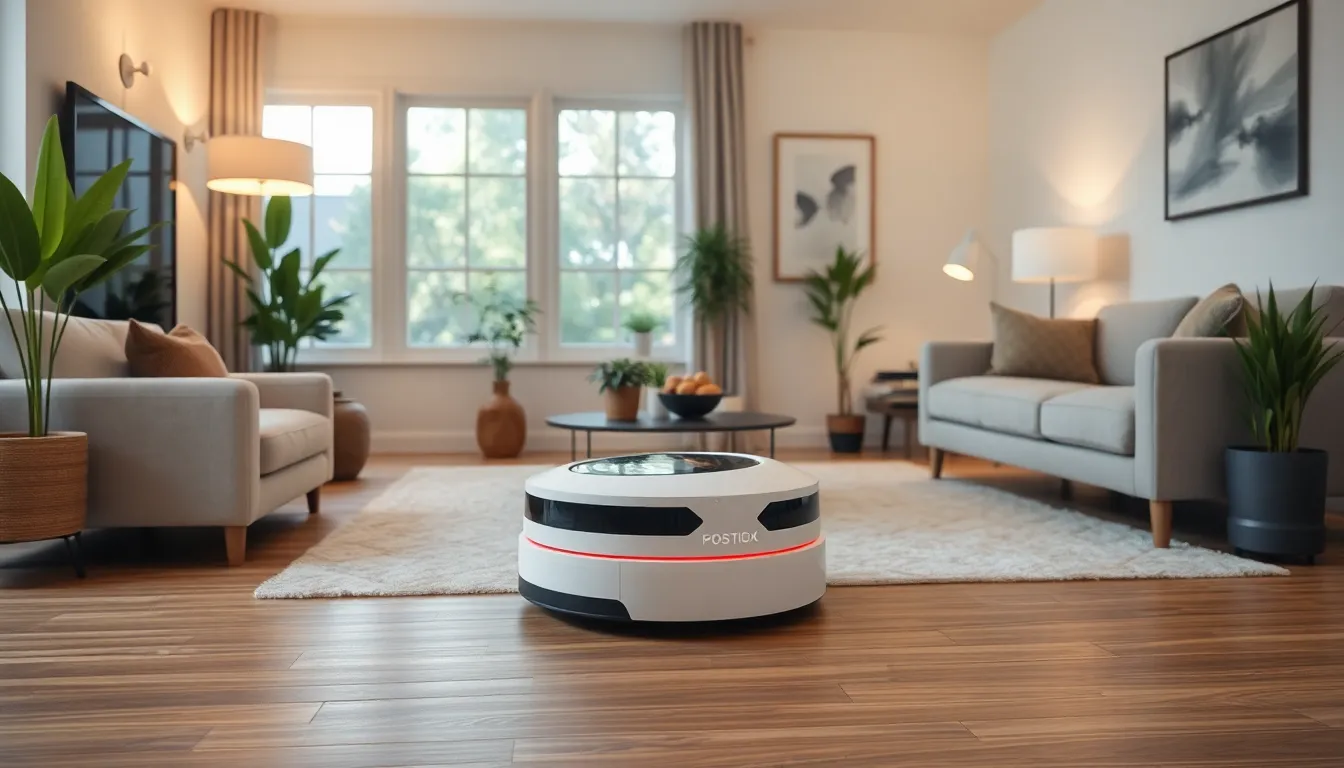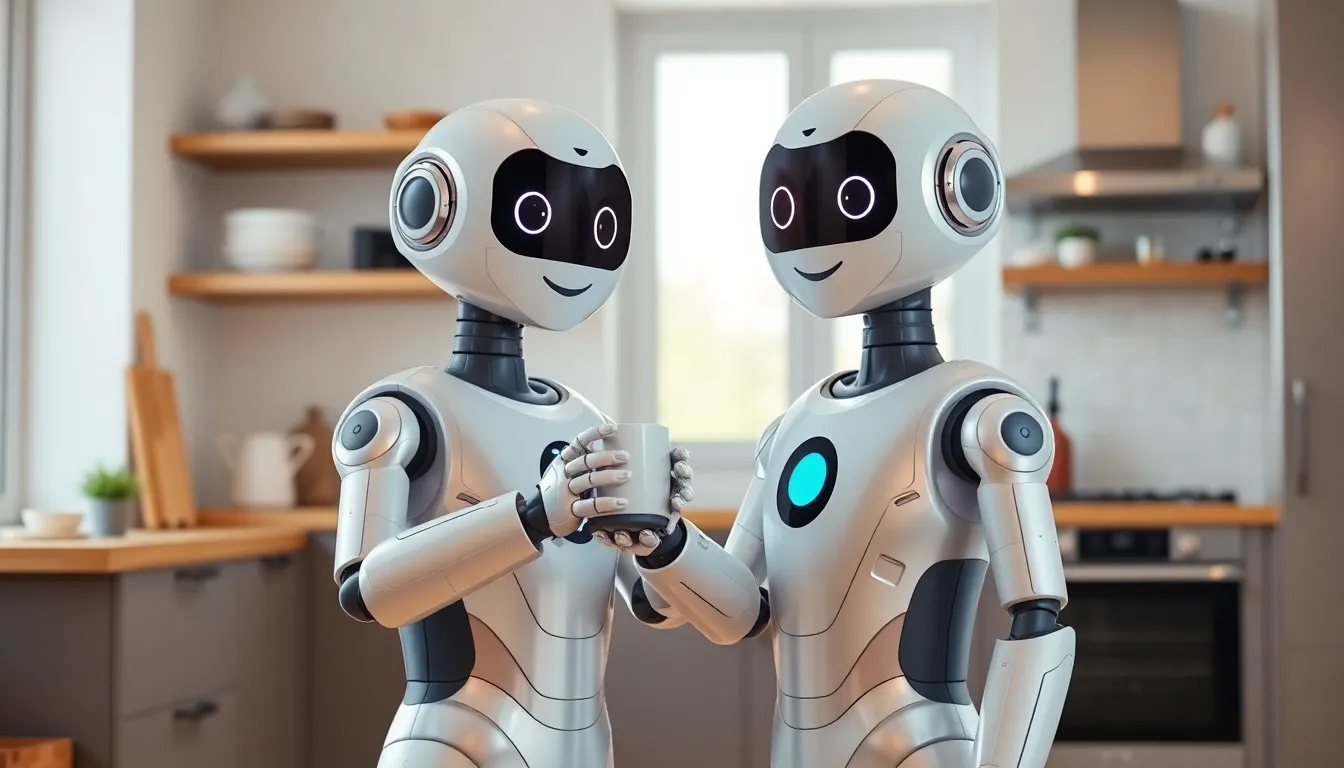Imagine a world where your coffee brews itself, your groceries get delivered by a friendly robot, and your chores vanish faster than socks in a dryer. Welcome to the age of service robots, where technology meets convenience in the most entertaining ways. These mechanical marvels aren’t just for sci-fi movies anymore; they’ve rolled right into our homes and workplaces, ready to lend a hand—or a wheel.
Table of Contents
ToggleOverview of Service Robots
Service robots encompass a wide range of automated machines designed to perform tasks that assist humans. In various sectors such as healthcare, hospitality, and retail, these robots enhance efficiency and complement human workers. Routine activities like cleaning, delivery, and customer assistance benefit significantly from robotic integration.
Healthcare facilities widely deploy service robots for patient care and logistics. Robots deliver medications and transport equipment, minimizing wait times and ensuring resource availability. They also assist in monitoring patient conditions, collecting data, and providing companionship, enhancing overall patient experiences.
In the hospitality industry, service robots greet guests, deliver room service, and provide information. Examples include robotic servers in restaurants and concierge robots in hotels. Such deployments improve service speed while allowing staff to focus on more complex tasks that require human interaction.
Retail businesses utilize service robots for inventory management and customer service. Robots can perform stock checks and assist customers in locating products, thereby streamlining operations. Automated kiosks and chatbots serve as vital tools, addressing inquiries quickly and enhancing customer satisfaction.
The growing presence of service robots illustrates a shift towards automation in daily life. Their impact on efficiency and productivity is significant, transforming both homes and workplaces. As technology advances, the potential applications of service robots continue to expand, paving the way for a smarter, more automated future.
Types of Service Robots

Service robots come in various forms, each tailored for specific tasks in different sectors. Here are some main types of service robots:
Household Service Robots
Household service robots assist with domestic chores, making daily life more convenient. Robotic vacuum cleaners, like Roomba, efficiently clean floors while users focus on other activities. Lawn-mowing robots automate yard maintenance, ensuring well-groomed landscapes with minimal effort. Additionally, some robots provide companionship, engaging in conversations or playing games with users. These innovations save time and enhance comfort in home environments.
Industrial Service Robots
Industrial service robots streamline operations on factory floors and assembly lines. Robotic arms automate repetitive tasks, increasing production efficiency and precision. Autonomous mobile robots transport materials and products, optimizing workflow within manufacturing facilities. Furthermore, they reduce workplace accidents by taking over dangerous tasks, protecting human workers. The integration of these robots helps companies meet growing demands and maintain competitiveness.
Medical Service Robots
Medical service robots play crucial roles in healthcare settings, enhancing patient care and operational efficiency. Surgical robots assist surgeons with precision during complex procedures, improving outcomes. Robots that help with logistics ensure supplies, such as medication and equipment, reach the right places promptly. Rehabilitation robots aid in physical therapy, offering personalized support for patients recovering from injuries. These technologies contribute significantly to advancing patient experiences and outcomes.
Hospitality Service Robots
Hospitality service robots enhance guest experiences in hotels and restaurants. Robots like Siri or Bella greet guests and provide information during check-in or dining experiences. Room service robots deliver food and amenities directly to guests, minimizing wait times. In addition, robotic concierges offer recommendations for local attractions, enhancing the overall stay. These innovations allow human staff to focus on tasks requiring personal attention, improving service quality and efficiency.
Benefits of Service Robots
Service robots play a crucial role in enhancing efficiency, reducing costs, and improving customer experiences across various sectors.
Increased Efficiency
Service robots streamline operations, allowing businesses to increase output without compromising quality. In healthcare settings, robots complete repetitive tasks like delivering medications and organizing supplies, freeing up healthcare professionals to focus on patient care. Restaurants benefit from robots that take orders and deliver food, speeding up service times. Robots navigate environments autonomously, which eliminates human error in tasks such as inventory management. Ultimately, adopting service robots leads to smoother workflows and higher productivity levels in numerous industries.
Cost Savings
Implementing service robots results in significant cost reductions for businesses. Labor costs decrease as robots handle tasks traditionally performed by human workers, leading to savings in wages and benefits. For instance, a retail company can cut overhead by deploying robots for stock management and customer interactions. Maintenance costs also decline, as robots typically require less routine oversight than human employees. Economic analyses show companies can recoup initial investments in service robots within a few years, illustrating their potential to strengthen financial health.
Enhanced Customer Experience
Service robots elevate customer interactions and contribute to satisfaction. In hospitality, robots greet guests, provide information, and assist with check-in processes, ensuring a seamless experience from the start. Retail businesses use robots for personalized assistance, helping customers find products quickly and efficiently. Through these interactions, service robots deliver consistent responses, helping build trust. By reducing wait times and enhancing service quality, they create positive impressions that lead to customer loyalty. Through service robots, businesses foster engaging experiences essential for retention and growth.
Challenges of Implementing Service Robots
Implementing service robots presents several challenges, impacting their integration into everyday operations across various sectors.
Technical Limitations
Technical limitations often hinder service robot performance. Many robots rely on advanced sensors and AI algorithms, which can struggle in unstructured environments. Navigation difficulties can occur when faced with obstacles or varying floor conditions. Furthermore, limited battery life restricts the time robots can operate independently. Software glitches or system malfunctions can lead to inefficiencies, impacting workflow. As machines strive for higher levels of autonomy, these limitations must be addressed to ensure reliable performance.
Acceptance and Trust Issues
Acceptance and trust issues pose significant barriers to widespread usage. Consumers often feel hesitant to interact with robots due to fears regarding safety and reliability. Humans may also feel uncomfortable when tasks typically performed by them are delegated to machines. Building user acceptance requires consistent performance and clear communication about robot capabilities. Service robots must also demonstrate reliability and safety adherence to gain public trust. Overcoming these issues is crucial for maximizing service robots’ potential.
Regulatory Concerns
Regulatory concerns complicate the deployment of service robots. Compliance with existing laws and regulations is often unclear, leading to uncertainty among businesses. Various industries face specific guidelines related to safety, privacy, and liability. These regulations can vary widely by region, complicating cross-border implementations. Stakeholders must navigate these complexities to ensure compliance while innovating. Addressing regulatory concerns is essential for the long-term success of service robots in different sectors.
Future Trends in Service Robots
Service robots constantly evolve, driven by advancements in technology and changing consumer needs. The future promises even more profound transformations across various sectors.
Advancements in AI and Machine Learning
Artificial intelligence and machine learning push the boundaries of service robots. AI enables better decision-making and adaptation to dynamic environments. Machine learning algorithms improve robots’ capabilities through experience, allowing for enhanced interactions with humans. Robots equipped with these technologies can learn from their surroundings, recognize patterns, and make predictions, all of which lead to improved functionality. These innovations pave the way for more autonomous and efficient service robots.
Integration with Smart Home Systems
Service robots increasingly integrate with smart home systems. This connectivity allows them to interact seamlessly with other smart devices like thermostats and security systems. Such integration enhances the user experience by enabling robots to respond to commands via smartphones or virtual assistants. Homeowners benefit from automation, simplifying tasks like scheduling cleaning sessions or managing household security. As smart home technology advances, robots will further integrate these systems, providing a more cohesive and efficient living environment.
Expansion into New Industries
Service robots expand into sectors beyond traditional applications. Industries such as agriculture, construction, and logistics embrace robotic solutions to improve efficiency and productivity. In agriculture, robots assist with planting, monitoring crops, and harvesting. Construction sites benefit from robots capable of performing repetitive or dangerous tasks, enhancing safety and efficiency. Logistics companies rely on robots for inventory management and last-mile delivery solutions, streamlining supply chains. This diversification highlights the growing acknowledgment of automation’s potential across various markets.
Service robots are reshaping the landscape of daily life and various industries. Their ability to enhance efficiency and streamline operations is proving invaluable in sectors like healthcare, hospitality, and retail. As these robots continue to evolve with advancements in technology, their integration into homes and workplaces becomes increasingly seamless.
The potential benefits are significant, from cost savings to improved customer experiences. However, addressing the challenges of implementation is essential for realizing their full capabilities. Trust and acceptance among consumers must grow alongside technological advancements.
Looking ahead, the expansion of service robots into new industries promises to further transform how tasks are performed. Embracing this shift towards automation will undoubtedly pave the way for a smarter, more efficient future.



